Abstract
Neurophysiological observations were made on normal subjects and on 57 patients who had had injuries to the spinal cord. The amplitude of the muscle compound action potential (M response) recorded from triceps surae in response to supramaximal stimulation of the tibial nerve was reduced in the patients indicating that there are changes in motor units below the level of a spinal lesion in man. In the patients who were clinically spastic it was found that: (1) The proportion of the triceps surae motoneuron pool reflexly activated either by tapping the Achilles tendon or by stimulating the tibial nerve just below the threshold of the alpha motoneuron axons (H reflex) was greater than in normal subjects. This can be explained by an increase in the excitability of central reflex pathways. (2) Vibration of the tendo Achilles depressed the H reflex less effectively than in normal subjects. This may indicate altered transmission in the premotoneuronal portion of the H reflex pathway. (3) The H reflex elicited 50 and 100 ms after a standardised conditioning stimulus to the tibial nerve and expressed as percentage of the unconditioned reflex was greater than in normal subjects. This could reflect a change in the excitability of motoneurons or of interneurons.
Full text
PDF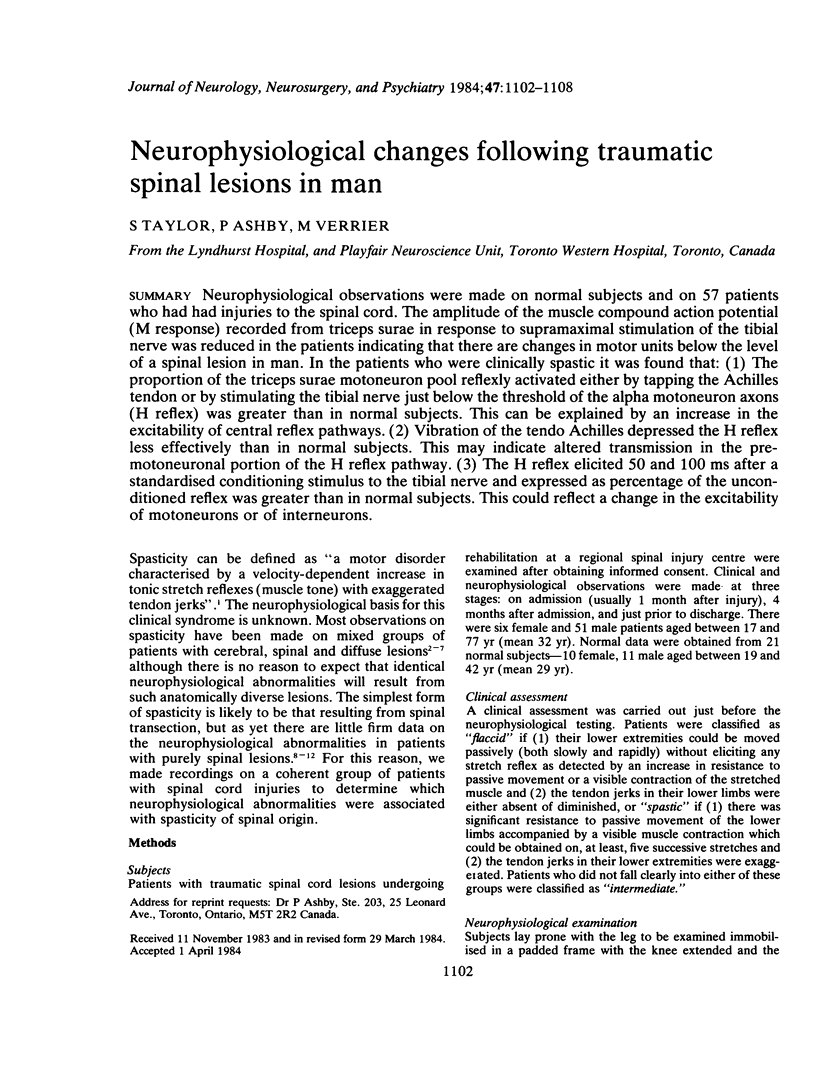
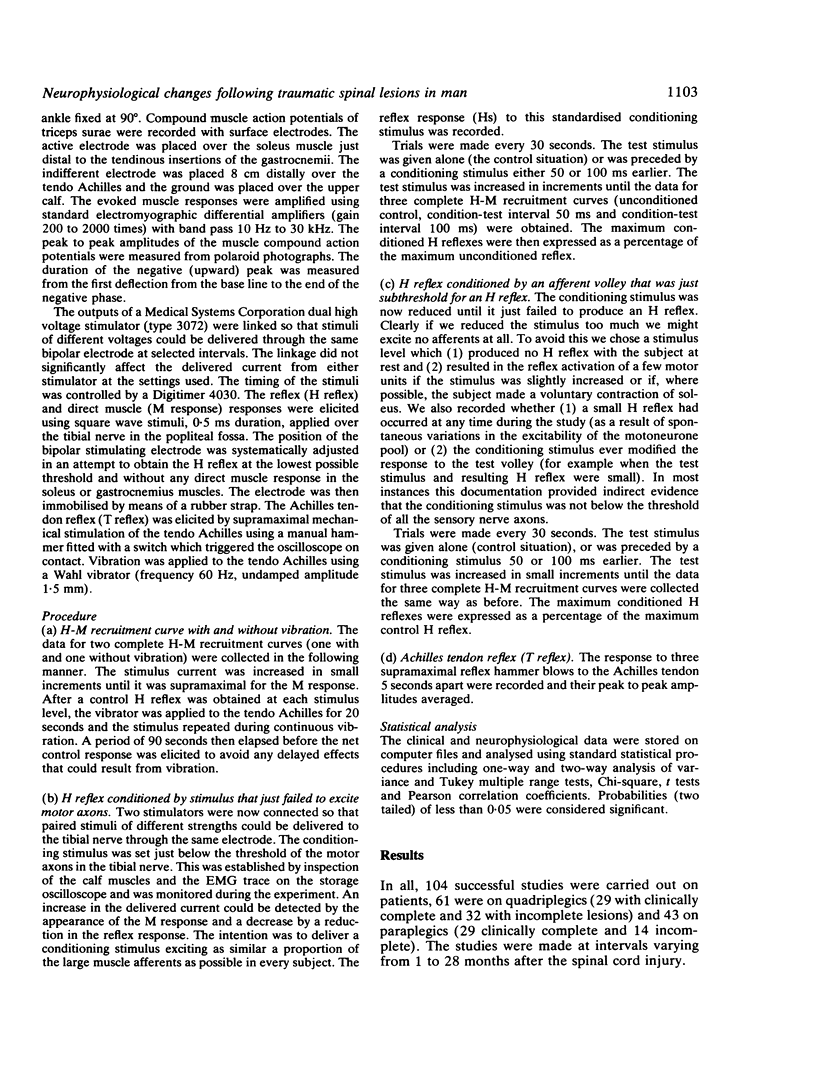
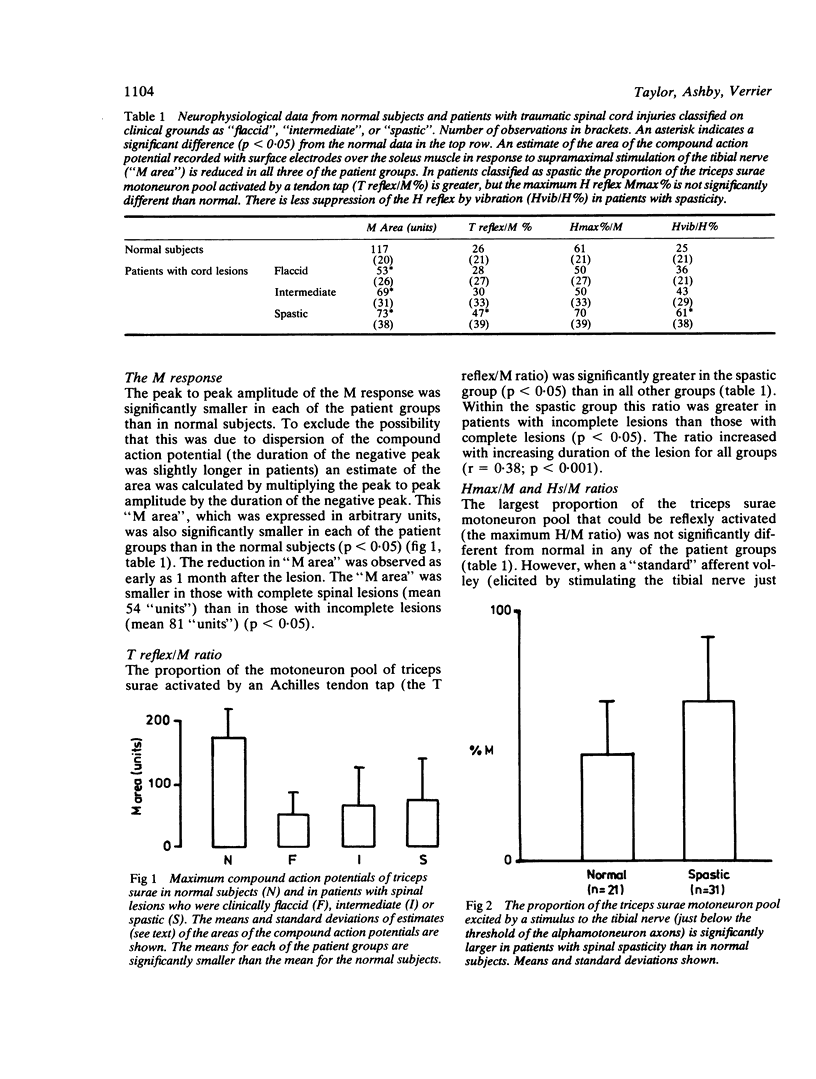
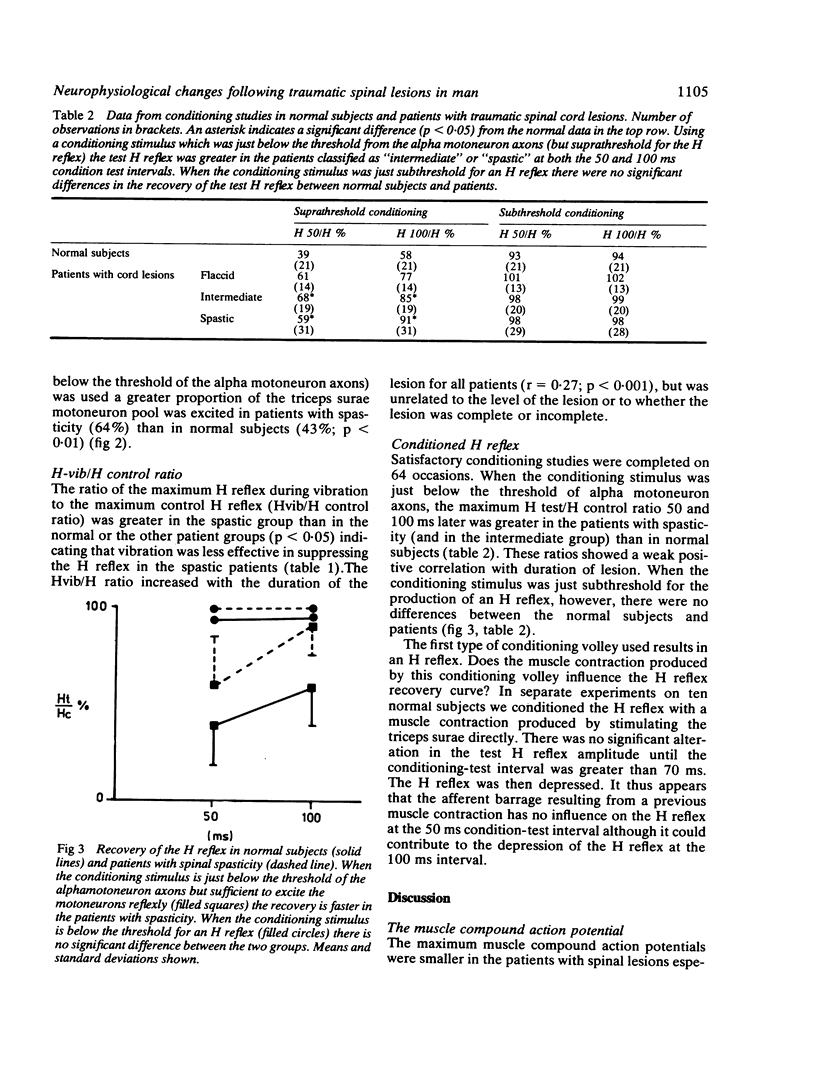
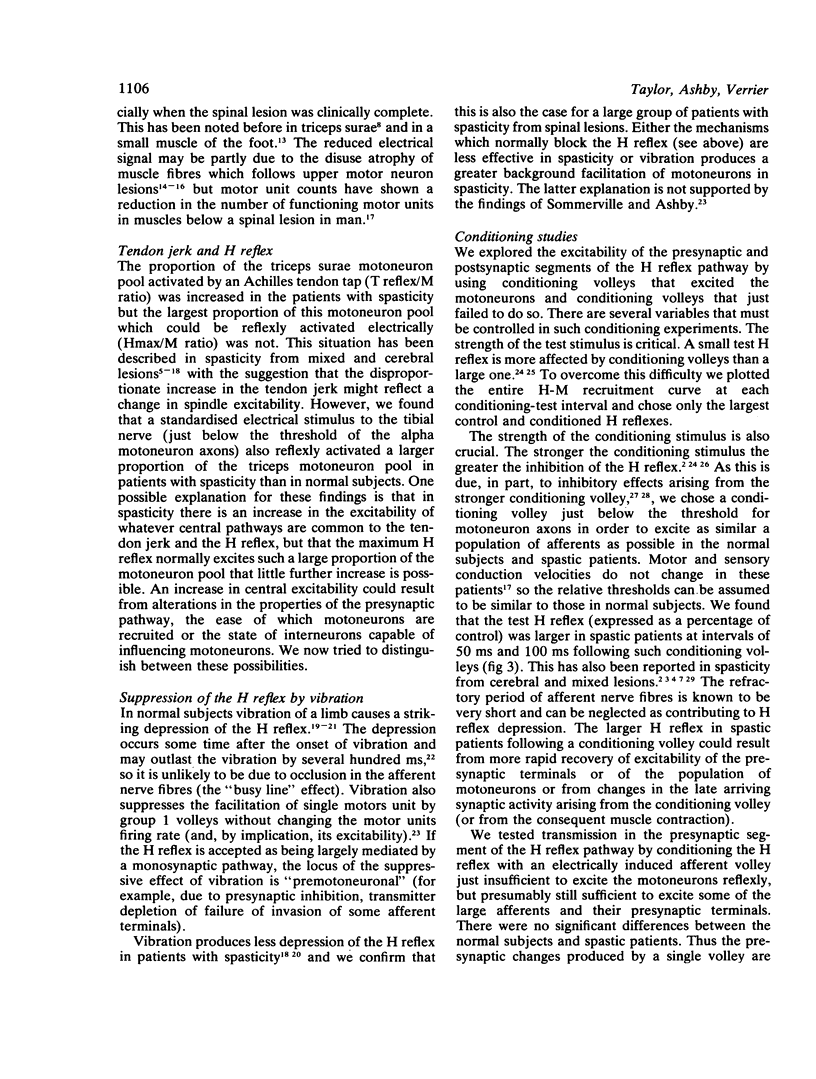
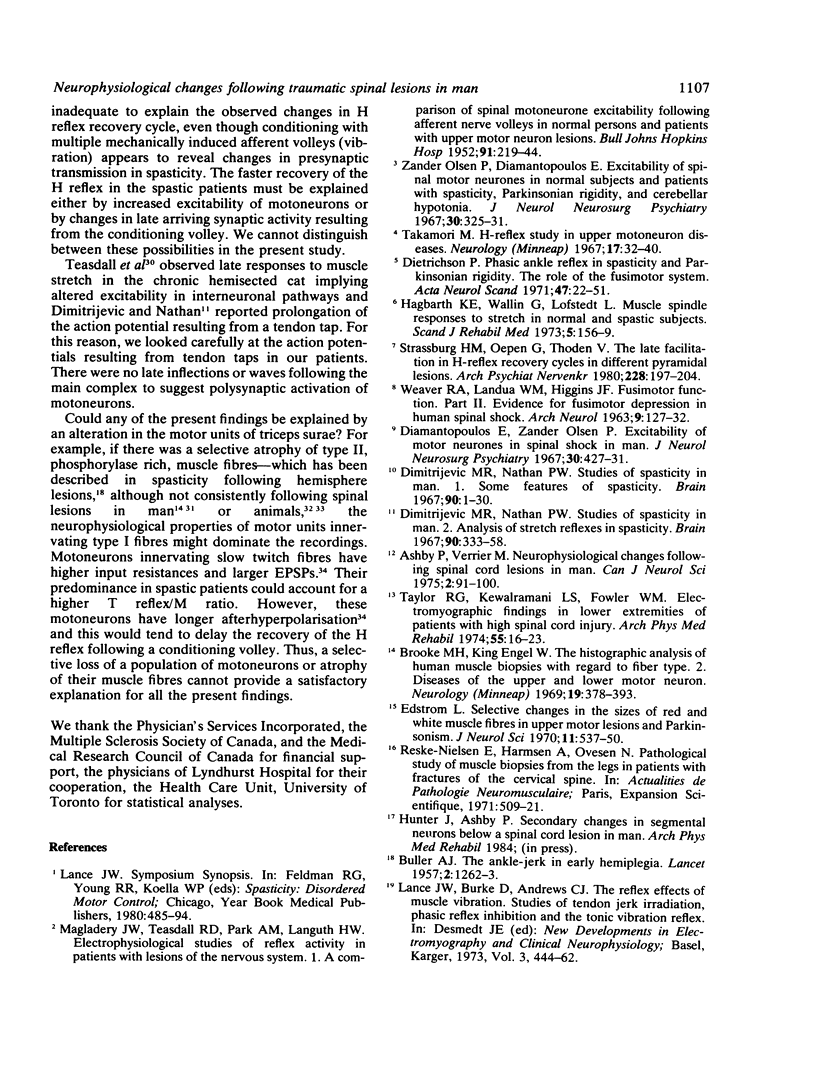
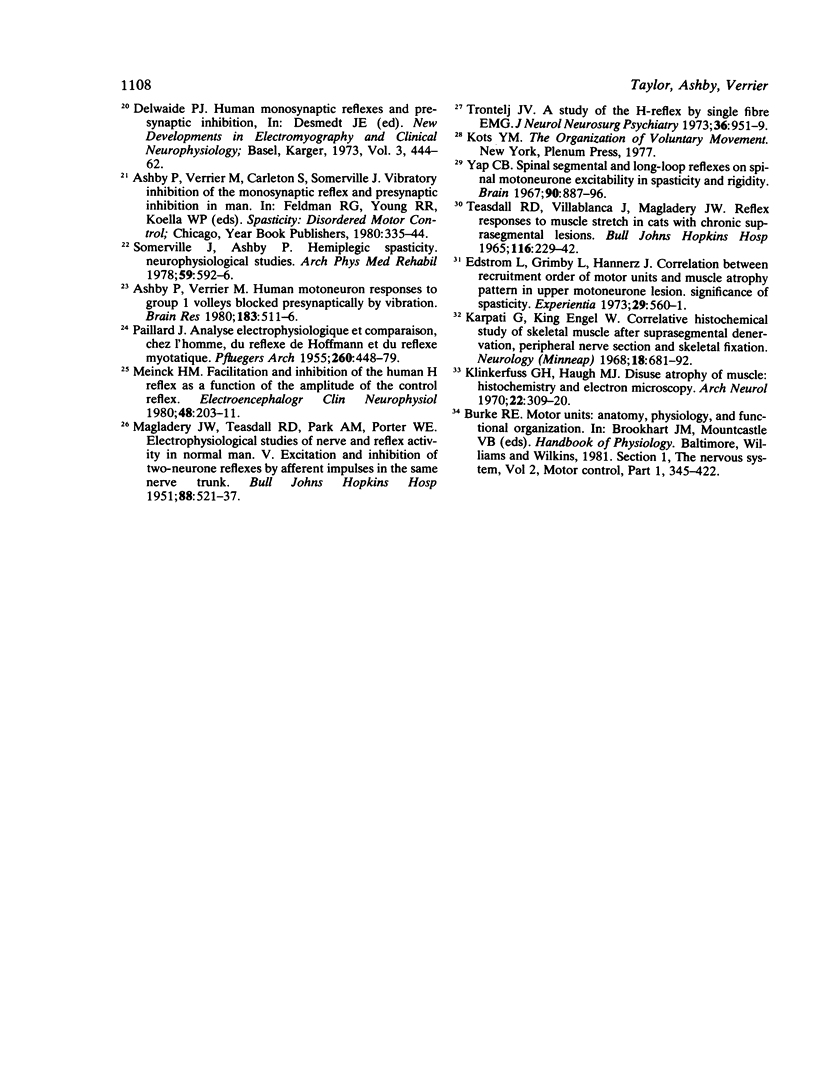
Selected References
These references are in PubMed. This may not be the complete list of references from this article.
- Ashby P., Verrier M. Human motoneuron responses to group 1 volleys blocked presynaptically by vibration. Brain Res. 1980 Feb 24;184(2):511–516. doi: 10.1016/0006-8993(80)90819-7. [DOI] [PubMed] [Google Scholar]
- Ashby P., Verrier M. Neurophysiological changes following spinal cord lesions in man. Can J Neurol Sci. 1975 May;2(2):91–100. doi: 10.1017/s0317167100020060. [DOI] [PubMed] [Google Scholar]
- BULLER A. J. The ankle-jerk in early hemiplegia. Lancet. 1957 Dec 21;273(7008):1262–1263. doi: 10.1016/s0140-6736(57)91543-x. [DOI] [PubMed] [Google Scholar]
- Brooke M. H., Engel W. K. The histographic analysis of human muscle biopsies with regard to fiber types. 2. Diseases of the upper and lower motor neuron. Neurology. 1969 Apr;19(4):378–393. doi: 10.1212/wnl.19.4.378. [DOI] [PubMed] [Google Scholar]
- Diamantopoulos E., Zander Olsen P. Excitability of motor neurones in spinal shock in man. J Neurol Neurosurg Psychiatry. 1967 Oct;30(5):427–431. doi: 10.1136/jnnp.30.5.427. [DOI] [PMC free article] [PubMed] [Google Scholar]
- Dietrichson P. Phasic ankle reflex in spasticity and Parkinsonian rigidity. The role of the fusimotor system. Acta Neurol Scand. 1971;47(1):22–51. doi: 10.1111/j.1600-0404.1971.tb07462.x. [DOI] [PubMed] [Google Scholar]
- Dimitrijević M. R., Nathan P. W. Studies of spasticity in man. I. Some features of spasticity. Brain. 1967 Mar;90(1):1–30. doi: 10.1093/brain/90.1.1. [DOI] [PubMed] [Google Scholar]
- Dimitrijevíc M. R., Nathan P. W. Studies of spasticity in man. 2. Analysis of stretch reflexes in spasticity. Brain. 1967 Jun;90(2):333–358. doi: 10.1093/brain/90.2.333. [DOI] [PubMed] [Google Scholar]
- Edström L., Grimby L., Hannerz J. Correlation between recruitment order of motor units and muscle atrophy pattern in upper motoneurone lesion: significance of spasticity. Experientia. 1973 May 15;29(5):560–561. doi: 10.1007/BF01926664. [DOI] [PubMed] [Google Scholar]
- Edström L. Selective changes in the sizes of red and white muscle fibres in upper motor lesions and Parkinsonism. J Neurol Sci. 1970 Dec;11(6):537–550. doi: 10.1016/0022-510x(70)90104-8. [DOI] [PubMed] [Google Scholar]
- Hagbarth K. E., Wallin G., Löfstedt L. Muscle spindle responses to stretch in normal and spastic subjects. Scand J Rehabil Med. 1973;5(4):156–159. [PubMed] [Google Scholar]
- Karpati G., Engel W. K. Correlative histochemical study of skeletal muscle after suprasegmental denervation, peripheral nerve section, and skeletal fixation. Neurology. 1968 Jul;18(7):681–692. doi: 10.1212/wnl.18.7.681. [DOI] [PubMed] [Google Scholar]
- Klinkerfuss G. H., Haugh M. J. Disuse atrophy of muscle; histochemistry and electron microscopy. Arch Neurol. 1970 Apr;22(4):309–320. doi: 10.1001/archneur.1970.00480220023005. [DOI] [PubMed] [Google Scholar]
- MAGLADERY J. W., TEASDALL R. D., PARK A. M., LANGUTH H. W. Electrophysiological studies of reflex activity in patients with lesions of the nervous system. I. A comparison of spinal motoneurone excitability following afferent nerve volleys in normal persons and patients with upper motor neurone lesions. Bull Johns Hopkins Hosp. 1952 Oct;91(4):219–passim. [PubMed] [Google Scholar]
- Meinck H. M. Facilitation and inhibition of the human H reflex as a function of the amplitude of the control reflex. Electroencephalogr Clin Neurophysiol. 1980 Feb;48(2):203–211. doi: 10.1016/0013-4694(80)90305-3. [DOI] [PubMed] [Google Scholar]
- Olsen P. Z., Diamantopoulos E. Excitability of spinal motor neurones in normal subjects and patients with spasticity, Parkinsonian rigidity, and cerebellar hypotonia. J Neurol Neurosurg Psychiatry. 1967 Aug;30(4):325–331. doi: 10.1136/jnnp.30.4.325. [DOI] [PMC free article] [PubMed] [Google Scholar]
- PAILLARD J. Analyse électrophysiologique et comparaison, chez l'homme, du réflexe de Hoffmann et du réflexe myotatique. Pflugers Arch. 1955;260(6):448–479. doi: 10.1007/BF00363666. [DOI] [PubMed] [Google Scholar]
- Somerville J., Ashby P. Hemiplegic spasticity: neurophysiologic studies. Arch Phys Med Rehabil. 1978 Dec;59(12):592–596. [PubMed] [Google Scholar]
- Strassburg H. M., Oepen G., Thoden U. The late facilitation in H-reflex recovery cycles in different pyramidal lesions. Arch Psychiatr Nervenkr (1970) 1980;228(3):197–204. doi: 10.1007/BF00342345. [DOI] [PubMed] [Google Scholar]
- TEASDALL R. D., VILLABLANCA J., MAGLADERY J. W. REFLEX RESPONSES TO MUSCLE STRETCH IN CATS WITH CHRONIC SUPRASEGMENTAL LESIONS. Bull Johns Hopkins Hosp. 1965 Apr;116:229–242. [PubMed] [Google Scholar]
- Takamori M. H reflex study in upper motoneuron diseases. Neurology. 1967 Jan;17(1):32–40. doi: 10.1212/wnl.17.1.32. [DOI] [PubMed] [Google Scholar]
- Taylor R. G., Kewalramani L. S., Fowler W. M., Jr Electromyographic findings in lower extremities of patients with high spinal cord injury. Arch Phys Med Rehabil. 1974 Jan;55(1):16–23. [PubMed] [Google Scholar]
- Trontelj J. V. A study of the H-reflex by single fibre EMG. J Neurol Neurosurg Psychiatry. 1973 Dec;36(6):951–959. doi: 10.1136/jnnp.36.6.951. [DOI] [PMC free article] [PubMed] [Google Scholar]
- WEAVER R. A., LANDAU W. M., HIGGINS J. F. FUSIMOTOR FUNCTION. II. EVIDENCE OF FUSIMOTOR DEPRESSION IN HUMAN SPINAL SHOCK. Arch Neurol. 1963 Aug;9:127–132. doi: 10.1001/archneur.1963.00460080037004. [DOI] [PubMed] [Google Scholar]
- Yap C. B. Spinal segmental and long-loop reflexes on spinal motoneurone excitability in spasticity and rigidity. Brain. 1967 Dec;90(4):887–896. doi: 10.1093/brain/90.4.887. [DOI] [PubMed] [Google Scholar]


